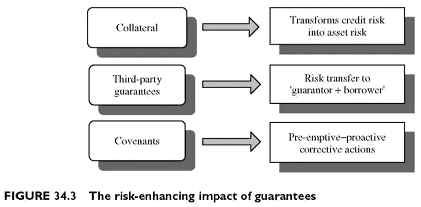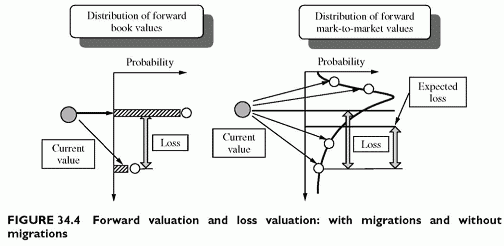RECOVERY RISK
Category: Risk Management in Banking
The traditional credit culture stipulates that lending is primarily dependent on the credit standing of borrowers, not on covenants or guarantees. The rationale behind this prudent rule is that there is always a residual, small or significant, risk whatever the guarantees. In addition, the credit standing of the borrower ultimately makes the loan perform or not.
However, ignoring the value of guarantees would be misleading given their importance in lending decisions and their mitigating effect on loss under default. The loss in the event of default is the amount at risk at default time less recoveries. The New Basel Accord recognizes that some guarantees deserve recognition in assessing losses.
The main guarantees are:
• Collaterals, which are assets seized by the lender if the borrower defaults.
• Third-party protections. For guarantees, the guarantor fulfils the obligation of the borrower if he defaults. For insurance or credit derivative protections, a third party provides a payment to the lender under default.
• Covenants, which are contractual clauses such as maximum debt cover ratio or a legal obligation not to diversify away from the core business. Breaches of covenants trigger an obligation of prompt repayment, which prevents the borrower from continuing operations unless he gets a waiver. They are strong incentives to renegotiate with lenders in such instances.
Collaterals serve to limit both the lenders loss under default and the borrowers risk-taking propensity. A borrower is reluctant to give up the collateral whenever it has more value than the debt. Whenever the borrowers upside is higher than the value of debt, he has a powerful incentive to comply with the covenants.
On the other hand, a third-party guarantee does not provide any incentive for the lender to limit his risk propensity. However, it does reduce the probability of default, since default occurs only when both the primary borrower and the guarantor default. This is the double default or joint default. It provides a rationale for valuing the third-party guarantee as a reduction of the default probability, moving down from the borrowers default probability to the joint default probability of both obligors. The New Accord simply stipulates that the benefit of the third-party guarantee is a risk transfer to the guarantor. Chapter 40 expands the framework for valuing joint default probabilities in all cases where there is a borrower and a guarantor, which also includes insurance and usage of credit derivatives.
Another credit risk mitigant is the support from a third party, often a holding company of a borrower that is a subsidiary. Although support is informal and not contractual, it looks like a third-party guarantee. Its value depends on the supporting entity incentives and willingness to face the obligations of the direct borrower.
The common practical way to value guarantees is to summarize their effects into a recovery rate. The recovery rate is 100% minus the loss given default. The loss in the event of default, or loss under default, is:
Loss given default = exposure x (1 — recovery rate %) = exposure x Lgd %
Recovery data from historical experience serves for valuing such forfeits. Historical recovery rates are available from rating agencies for bonds. They are the ratio of the post-default price of a bond to its pre-default price. Such rates vary inversely with the level of seniority of debt and are evidently higher for a secured debt than for an unsecured debt. The evidence shows that recovery rates vary widely from one transaction to another, and from one type of guarantee to another. Therefore, there is a need to differentiate the recovery rate by transaction type, seniority level compared to other debts and guarantee type.
Potential recoveries in the event of default are uncertain. Recoveries require legal procedures, expenses and a significant lapse of time. They occur in the future, are context-dependent (the situation of an obligor at the time of default) and depend on the nature of credit risk mitigants. Collateral might not be accessible. Real assets are subject to deterioration simply because there are many incentives to take them away when debtors know that they will loose them. Legal guarantees are subject to enforceability risk, or recourse risk. Covenant values depend on the borrowers ability to recover from credit deterioration at the time of a breach. Related chapters discuss the recovery risks according to the source of recovery (collaterals, guarantees, covenants).
Figure 34.3 summarizes the basic mechanisms of the credit-enhancing effect of guarantees. Collaterals transform credit risk into legal plus asset value risk. Third-party guarantees and support reduce the default probability of the joint entity borrower + guarantor. Covenant values depend on how banks use them to prevent further risk deterioration. Chapters 40 and 41 expand the valuation of guarantees and the modelling recoveries.
STANDALONE RISK
Forward valuation is at the horizon. Under default mode, each transaction has either its book value or its recovery value under default. Under full valuation mode, each transaction has a distribution of values at the horizon resulting from all possible credit risk migrations, inclusive of the default state. Figure 34.4 shows what happens under default mode only and under full valuation of migration risk. In the first case, value remains at book value and drops to the estimated recovery value under default, while in the second case, value increases occur when there are upward migrations.
The technique of modelling the value distribution at a future time point is implemented in the chapter concluding the review of credit risk drivers by an assessment of standalone credit risk.


